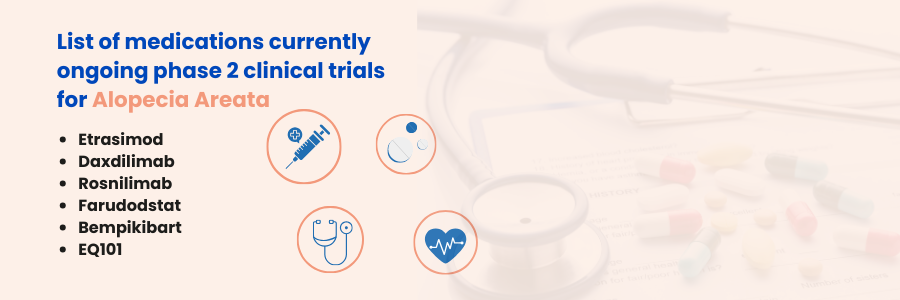Breakthrough Therapies for Alopecia Areata

Table of contents
Alopecia Areata (AA) is a condition characterized by unpredictable hair loss. The precise trigger of this immune response remains elusive, although it is thought to stem from an interplay of genetic and environmental factors.
The indication has seen significant advancement in treatment options. In the context of AA, the use of Janus Kinase (JAK) inhibitors has emerged as a transformative element in the treatment landscape.
Before 2022, AA treatment options were limited. The landscape changed with the introduction of Baricitinib by Eli Lilly in 2022 and Ritlecitinib by Pfizer in 2023. While these medications have been generally well-tolerated by patients, they do have known side effects that necessitate careful monitoring by the treating physician. Additionally, they are associated with a hefty price tag.
Issues with Existing Treatments

Lifelong Medication.
JAK inhibitors, despite their effectiveness, require lifelong adherence. Patients who discontinue the medication experience hair loss, leading to a cycle of regrowth and loss. It is important to note that once the hair is lost, it can take a significant amount of time to regrow. This often results in the patient entering a state of “chase”, constantly trying to catch up with the cycle of hair loss and regrowth. This underscores the need for consistent treatment to maintain hair growth and manage AA effectively.
Who Will Respond Well?
The response to treatment varies. Patients with less severe AA or shorter episodes tend to respond better, but not everyone responds to JAK inhibitors. Some patients, despite long-term use, can only regrow eyebrows and eyelashes but not hair.
Black Box Warning.
While the day-to-day side effects of these AA treatments are generally mild and manageable, including symptoms like upper respiratory tract infections, nasopharyngitis, and headaches, it is crucial to highlight the serious nature of the black box warnings associated with these treatments. These warnings indicate risks of severe infections, malignancy, cardiac events, and thrombosis. These are not to be taken lightly and necessitate careful consideration, particularly for patients with a history of clots or cancer.
Pediatrics And Pregnant Women.
Furthermore, these drugs are not approved for pediatric AA patients (younger than 12 years old) or for women who are pregnant or planning to become pregnant. When these women stop the medication due to pregnancy, they experience hair loss, highlighting a significant area for improvement.
Alternative Options
As previously discussed, although JAK inhibitors have helped significantly advance treatment options for AA, there is still a growing need for options to patients.
Some medications are currently being used off-label for the treatment of AA:
- Upadacitinib: This is a pan-JAK inhibitor with a priority for JAK1. It has a known safety profile. It is particularly effective for patients 12 years and above with atopic dermatitis (AD).
- Deucravacitinib: This is a tyrosine kinase 2 (TYK2) inhibitor. It is approved only for psoriasis and can cause pimples, a common side effect of JAK inhibitors. It is the only JAK inhibitor without a black box warning for now, which is promising.
Ongoing Phase 2 Clinical Trials
Following is a list of medications currently ongoing phase 2 clinical trials for AA:

- Etrasimod: This is a sphingosine 1-phosphate (S1P) receptor modulator. It was initially derived from a fungus metabolite, myriocin, that modulates the immune system. However, since it affects multiple S1P receptors, a careful review of data is essential to assess its safety and efficacy.
- Daxdilimab: An ILT7 protein antibody, commonly referred to as “the pDC depletor”, functions as a covering on the surface of plasmacytoid dendritic cells (pDCs). This covering facilitates the attraction of natural killer (NK) cells, which are then tasked with the elimination of the pDCs.
- Rosnilimab: This PD-1 agonist is often used in oncology. It reduces T-cell inflammation through 2 distinct mechanisms of action: depletion and agonism. It has shown a potent reduction in peripheral PD-1+ T Cells, sustained for more than 30 days.
- Farudodstat: This medication blocks DNA replication, thus exerting an immunosuppressive effect.
- Bempikibart: This IL-7R antibody affects CD 8+ cells.
- EQ101: This PEFylated peptide selectively inhibits IL-2/9/15 without suppressing other cytokines.
These new AA treatments represent the latest research, potentially offering alternatives to the current approved treatments.
As the industry welcomes new progress in AA, it becomes a common goal for these ongoing and upcoming trials to pave the way for the identification and endorsement of more potent and safe therapies for AA. This, in turn, will enhance the life quality of patients afflicted with this condition.
Let’s shape the future of research and make a difference in the industry, gain Innovaderm’s support in your upcoming trial and propel your study to new heights.
About the Author
Dr. Natasha Mesinkovska, MD PHD
Dr. Mesinkovska is a distinguished dermatologist at the University of California, Irvine (UCI) School of Medicine’s Department of Dermatology, specializing in skin disorders and hair loss. She is an active researcher with numerous publications on alopecia, atopic dermatitis, psoriasis, and skin laxity. Dr. Mesinkovska completed her medical training at the Cleveland Clinic Foundation and Mayo Clinic Alix School of Medicine. Recognized as a leading expert on alopecia in the U.S., she has significantly contributed to the growth of UCI’s Dermatology Clinical Research Center.
Newsletter
Newsletter subscription resources

